With up to a 97% hunting success rate, dragonflies are one of the top predators on Earth.

Impressive eyesight, agility in the air and clever strategies make dragonflies incredibly successful predatory insects. © WildlifeWorld/ Shutterstock
In the UK, dragonflies are a welcome sign that the warmer months have arrived. From April to October, you’ll spot them busily zipping about over ponds and streams.
If they sit still long enough for you to take a good look, you’ll see a long-bodied insect with four large wings and enormous eyes. They can be quite colourful too, with bold reds and golden hues to eye-catching blues and greens.
But while beautiful to us, they’re an airborne terror for winged insects – dragonflies rarely miss when chasing down a meal. But what makes them such successful hunters?
How many eyes does a dragonfly have?
Sight is an important sense for dragonflies. They can’t hear and have a limited sense of smell, so their eyes are vital for navigating the world. Dragonfly brains may be tiny, but they can process about 200 images per second.
Most of a dragonfly’s head is taken up by its two goggle-like compound eyes. These can be so big that they meet in the middle on the top of the head. This gives dragonflies near-360° vision, which probably explains why it’s so difficult to sneak up on them before they flit away.
Dragonflies’ eyes work in a completely different way to our eyes, which by comparison, are rather simple structures.
If you look closely at a dragonfly’s eyes, you’ll find they’re a mosaic of units called ommatidia. Each ommatidium points in a slightly different direction and contains a tiny lens. While we have one lens in each eye, dragonflies can have as many as 30,000 lenses per eye.

Adult dragonflies have two enormous compound eyes and three small simple eyes. © natmac stock/ Shutterstock
Dragonflies also have three small and very sensitive simple eyes, or ocelli, on the front of their head. These have a single lens each. The ocelli may help dragonflies keep themselves stabilised in flight.
The insects likely see colour and light very differently to us. While we have three proteins in our eyes that are associated with colour vision, dragonflies have up to 30 proteins.
Some dragonfly species may even be able to detect ultraviolet polarised light bouncing off the surface of water. They might use this to know if the water is suitable to, for example, lay their eggs.
Dragonfly wings
To be the ultimate pursuit predator, dragonflies have a need for speed.
In fact, dragonflies are the world’s fastest flying insects. The record holder is the southern giant darner, Austrophlebia costalis, which lives in eastern Australia. It can race through the air at 58 kilometres per hour.
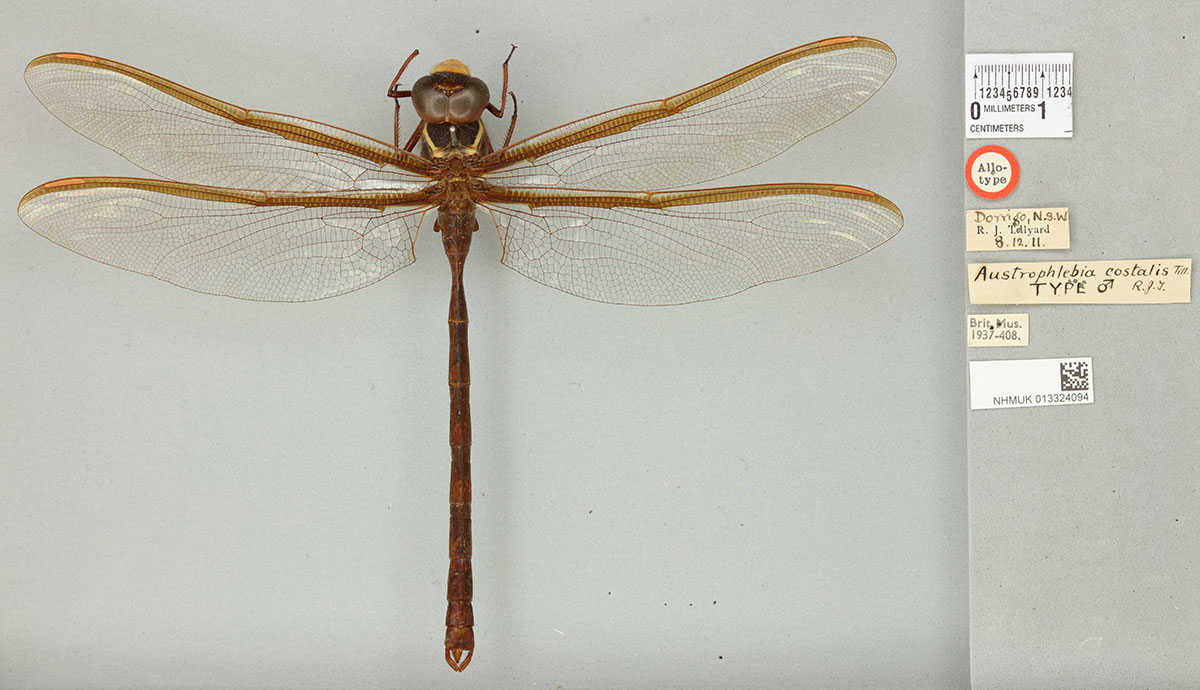
The southern giant darner is the fastest flying insect in the world. This specimen is part of the Odonata collection we care for.
Dragonflies reach impressive speeds by flapping their two pairs of wings, which are each powered by strong flight muscles.
In flight their wings are a blur, but at rest we can see that most dragonflies’ wings are transparent with a web of veins across them. These are filled with haemolymph – the insect equivalent of blood.
You may also spot small, dark patches near the tips of their wings. These are called pterostigma and they help increase the dragonfly’s gliding speed by reducing vibrations across the wings.
Dragonflies are incredibly agile in the air. They can control the angle and speed of each of their four wings independently. This lets them fly in any direction and hover.
There are hundreds of neurons in each wing that send feedback to the dragonfly’s brain, allowing it to control its flight with speed and precision. This incredible ability is inspiring bioengineers to find ways to make aircraft wings ‘live’ and respond to feedback during flight.
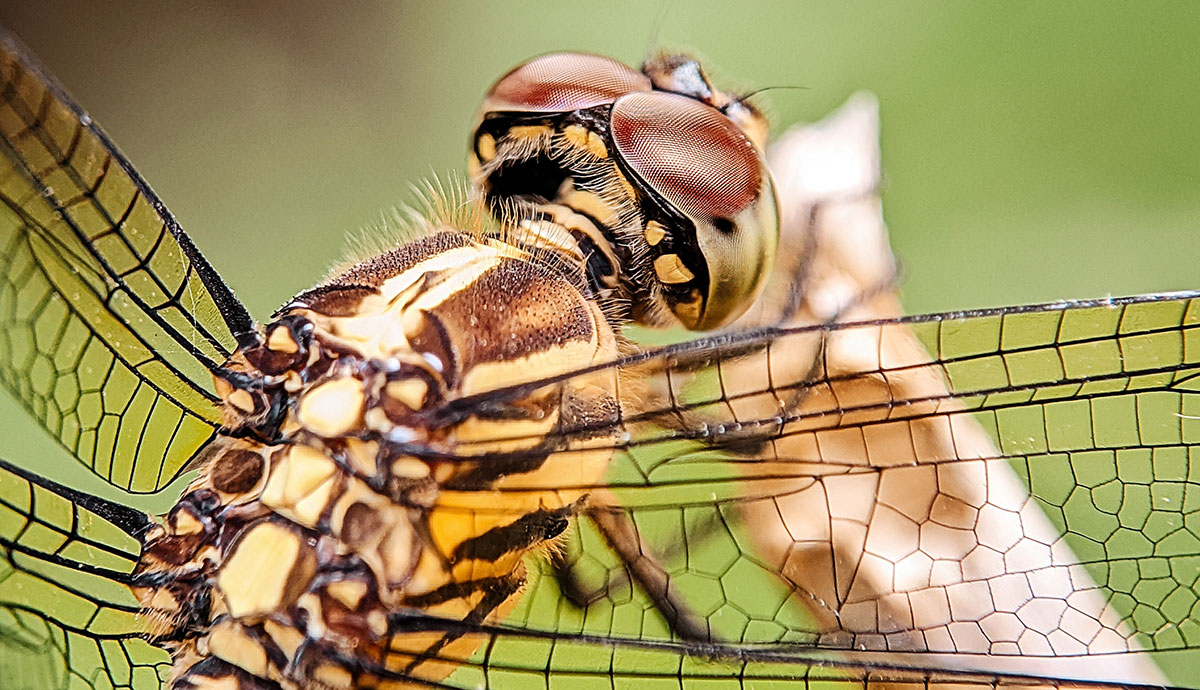
Dragonflies’ wings are powered by strong flight muscles. Each wing can move independently, making these very agile insects. © Ahmad sururudin/ Shutterstock
Hunting strategies
Dragonflies put their eyesight and agility to good use when seeking out their next meal.
We can roughly divide dragonflies into two groups based on their hunting strategies – perchers and hawkers.
Perchers sit and wait for prey to pass nearby. When it does, they launch and quickly intercept it. Hawkers are generally larger species that actively patrol a territory, seeking out potential meals on the wing before chasing them down.
Dragonflies are able to pick out moving prey in busy environments and predict where it’ll go – a bit like how we can track objects in motion. For example, when we catch a ball we instinctively process a lot of information. We consider the path and speed of the moving target and how fast we’re going to calculate where to intercept the object. Dragonflies work out how to catch prey in a similar way.
During a hunt, a dragonfly keeps its prey in sight. As the predator rotates its body to manoeuvre through the air during pursuit, it counter-rotates its head to keep the target in line with the region of its eyes with sharp focus.
Dragonflies also take advantage of their prey’s blind spot by ambushing from behind and below. When close enough, they use their long legs as a net, sweeping them forwards and upwards to catch their meal.
Adult dragonflies usually feast on other winged insects, including flies, bees, beetles, butterflies and other dragonflies. Incredibly, there are also cases where they’ve caught and eaten small birds.

Adult dragonflies eat a variety of flying insects – and sometimes even birds. © Chirantanusaikiaphotos/ Shutterstock
These skilful hunting strategies make dragonflies some of the most successful hunters on the planet, with capture rates of up to 97%.
How impressive that is becomes apparent when you compare dragonflies to other formidable predators.
For example, peregrine falcons are the fastest birds on the planet as they dive at 320 kilometres per hour after their prey. But studies have found they’re only successful up to about 47% of the time. Lions only have a 25% success rate despite their impressively sharp teeth and claws. While African wild dog packs are much more successful, their 85% hunting success rate means they’re still trailing behind dragonflies.
Do dragonflies bite?
Dragonflies subdue their prey with a bite from their large, sharp jaws.

Dragonflies belong to a group called Odonata, which means toothed mandible. © Pawich Sattalerd/ Shuttertock
While dragonflies are deadly for their insect prey, they aren’t typically aggressive to people. However, if dragonflies are handled roughly or feel threatened they may bite in self-defence or try and nibble their way free. While small species can’t break through skin, larger dragonflies have jaws powerful enough to draw blood.
What dragonflies can’t do is sting. They have long bodies that have a somewhat pointed end, but they don’t have a stinger or venom.
What’s the biggest dragonfly?
There are dragonflies on every continent except Antarctica and they come in a huge range of sizes.
The smallest dragonfly is the scarlet dwarf, Nannophya pygmaea, which has a wingspan of only two centimetres. It’s found from China to Japan, and down through southeast Asia.
The biggest dragonfly in the world is around eight times as large. The giant petaltail, Petalura ingentissima, has a wingspan of about 16 centimetres and can be up to about 12.5 centimetres long. It’s found in a small part of north-eastern Queensland in Australia.

The giant petaltail is the world’s largest dragonfly species.
Dragonflies are closely related to damselflies. They’re both part of a group called Odonata, in which there are around 6,000 species. Most of them live in the tropics.
In the UK and Ireland, there are 56 species of dragonfly and damselfly. Some are permanent residents and some migrate here. Other species, known as ‘vagrants’, turn up unexpectedly after being blown off course or are carried here by other means.
The golden ringed dragonfly, Cordulegaster boltonii, is the UK’s longest dragonfly species. Females reach about 8.4 centimetres long, with a wingspan of about 10 centimetres. The stunning blue and green emperor dragonfly, Anax imperator, is slightly shorter but has the widest wingspan of any UK dragonfly species at 10.5 centimetres.

This is a damselfly. It looks quite similar to a dragonfly, but there are ways to tell them apart. For example, damselflies’ bodies are often smaller and more delicate-looking. They also have bulbous eyes on the sides of their heads and usually fold their wings over their back at rest. Most dragonflies keep their wings spread out to the sides. © Sonja Ooms/ Shutterstock
Dragonfly lifecycle
The life of a dragonfly starts with an egg. These take about a week to hatch and the tiny baby dragonfly that emerges is known as a prolarva.
Young dragonflies then go through a series of moults. The first often happens almost immediately after hatching, with the prolarva transforming into a wingless nymph.
Dragonfly nymphs are aquatic, meaning they live in water. They’re formidable ambush predators, lying in wait among the sediment and vegetation for prey such as other aquatic insects, small tadpoles or even fish to pass by. They then deploy their hinged jaw, known as the labium, which shoots out and grabs their prey.

A dragonfly nymph holding a fish head with its extendible jaw. © Ernie Cooper/ Shutterstock
After up to 14 moults, a dragonfly nymph is ready to go through metamorphosis to become an adult. Unlike insects such as butterflies, which go through an intermediate pupa stage in a chrysalis, dragonflies go straight from a nymph to an adult.
The nymph crawls out of the water and slowly breaks out of their rigid exoskeleton in a process that can take a few hours. After revealing their adult dragonfly body and wings they can then take their first flight.

An adult emperor dragonfly emerges in our gardens. Image courtesy of Florin Feneru.
While the nymph stage can last years, adult dragonflies typically only live for a few weeks at most. Within days of metamorphosing, adult dragonflies are ready to find a mate.
Males can be territorial and get into dogfight-like aerial battles with rivals. Some species use a clever strategy called motion camouflage that makes it hard for a rival to detect the pursuing male’s movements. The dragonfly keeps itself constantly in line with the same spot in their quarry’s eyes, making themselves look like they’re stationary in the air, despite actually being in pursuit. They can then suddenly loom into view.
Like other insects, dragonflies’ bodies have three main segments – the head, the thorax and the abdomen. In dragonflies, the abdomen has 10 segments, with the tenth being the end of the tail. Before mating, the male transfers sperm forward from the ninth segment to secondary genitalia on the underside of the second segment.
The male then uses the claspers at the tip of his tail hold onto the back of the female dragonfly’s head. You might have seen dragonflies and damselflies flying around like this – the male is the one at the front.
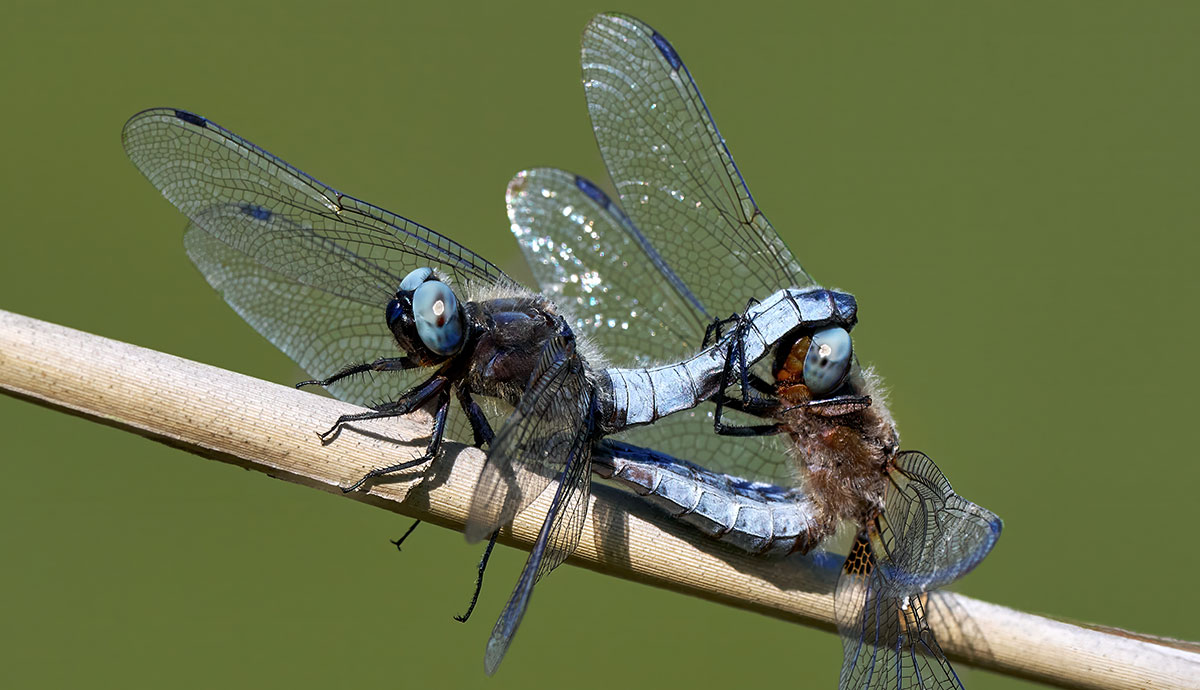
Dragonfly mating involves some complex choreography. © Robert Schneider/ Shutterstock
The female needs to transfer the sperm from the male’s second segment into an opening on the underside of her eighth segment. To do this, she curls her tail up to the male’s underside to collect it, with the pair forming a wheel or heart shape with their bodies. While this transfer is happening, the male can also scrape out sperm from the female’s previous mates.
Female dragonflies then head to water to lay their eggs. In some species, the male will guard the female to try and guarantee that his sperm fertilises her eggs.
Eggs are laid either on or in aquatic plants, inserted into mud or deposited directly into water. During their short lives, females can mate multiple times and lay hundreds of eggs in several batches.
With the eggs laid, the life cycle starts all over again.
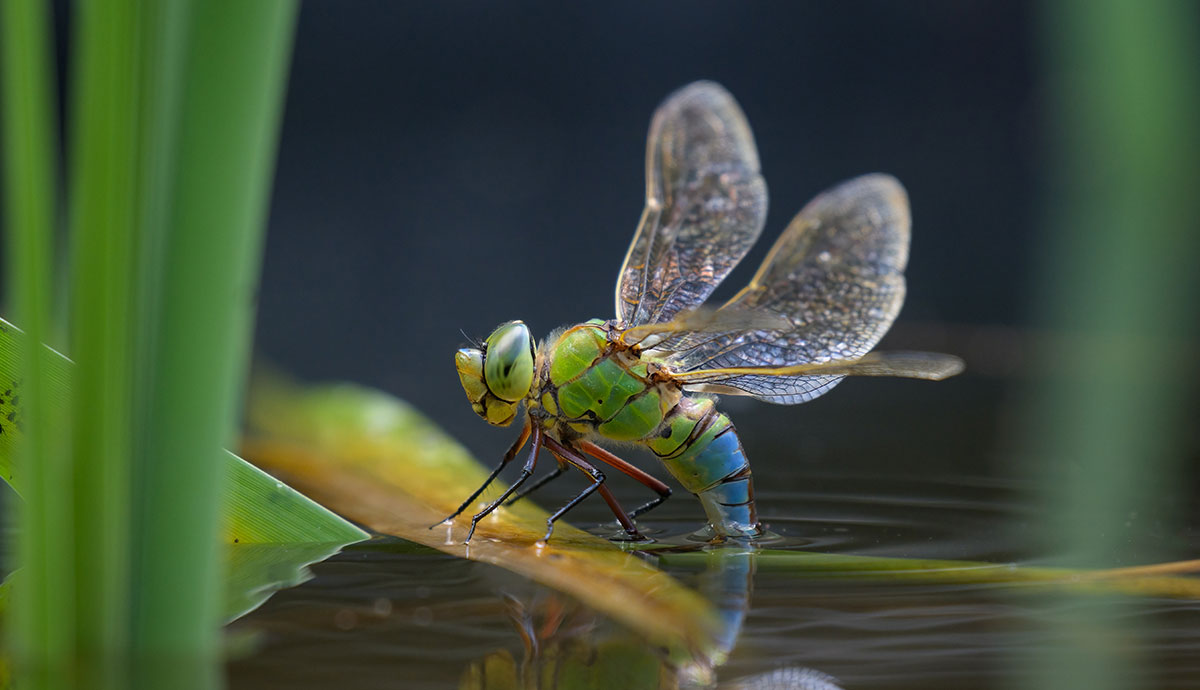
The emperor dragonfly, one of the UK’s largest dragonfly species, lays its eggs in floating aquatic plants. © Stefan Rotter/ Shutterstock
How can you help dragonflies?
The diversity of dragonflies in Britain is changing, mostly in response to climate change. For several species this is helping their populations grow. For example, the warming climate means emperor dragonflies are spreading further north.
But for other members of Odonata, climate change may be more of a problem. Our scientists and the Odonata collection we care for have been part of a study that found that some species are likely getting smaller in response to increased temperatures. Smaller females typically mean smaller batches of eggs.
Some species have also faced declines as their wetland habitats have dried out and land use has changed, for example through the expansion of agriculture.
If you want to help out, then dragonflies like water, plants to perch on and a healthy balance of sunlight and shade. You can provide a great habitat for young and adult dragonflies at home with a garden pond. It’ll help lots of other wildlife too.
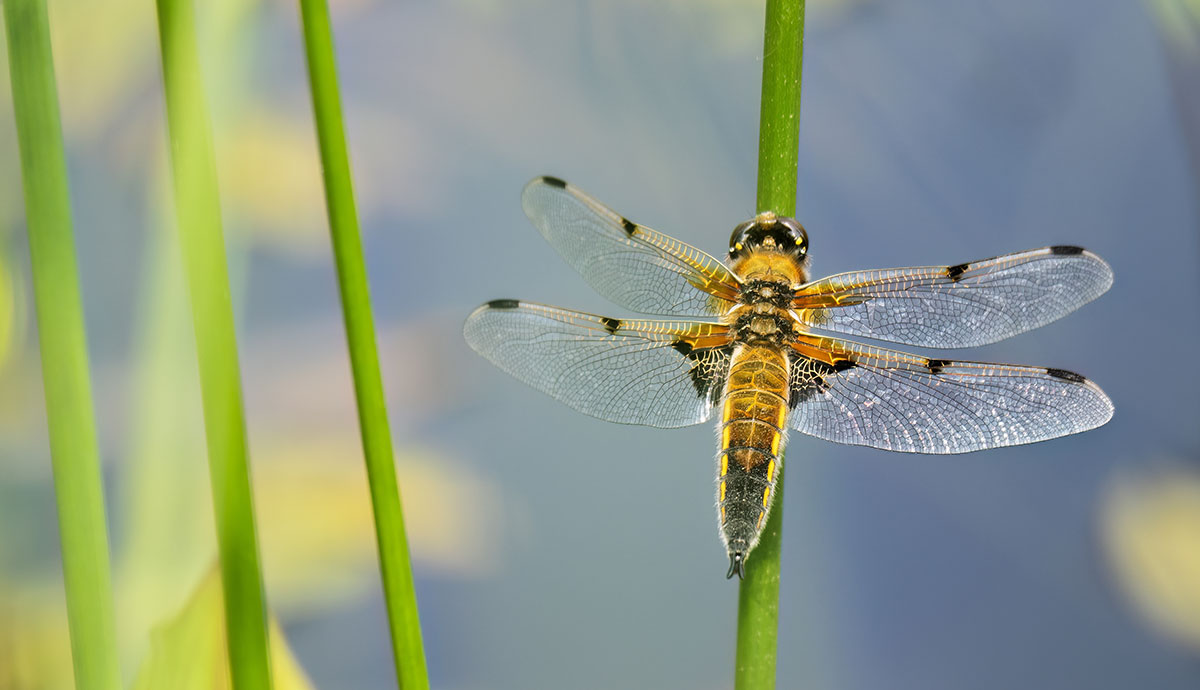
Adult dragonflies will perch on tall plants near water, such as reeds, to rest or wait for prey to fly by. © Sarah2/ Shutterstock
A pond for dragonflies needs a variety of aquatic plants – some that add oxygen to the water and others as places for adults to perch and to lay their eggs. It’s best to avoid adding fish to the pond as they’ll eat the nymphs. You should also keep the water free from pesticides and other harmful chemicals.
While dragonflies tend to prefer bigger ponds, they don’t always follow this rule. Why not create a mini pond in a pot? It’s a great option if you don’t have much outdoor space.
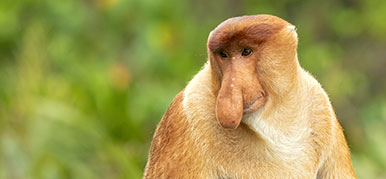
What on Earth?
Just how weird can the natural world be?

British wildlife
Find out about the plants and animals that make the UK home.
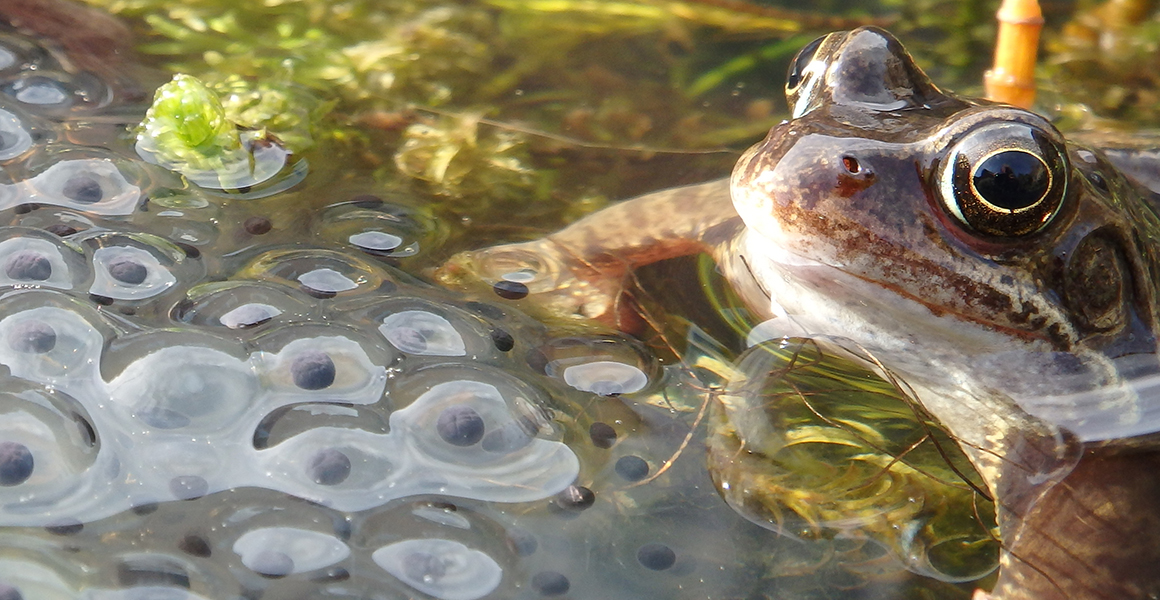


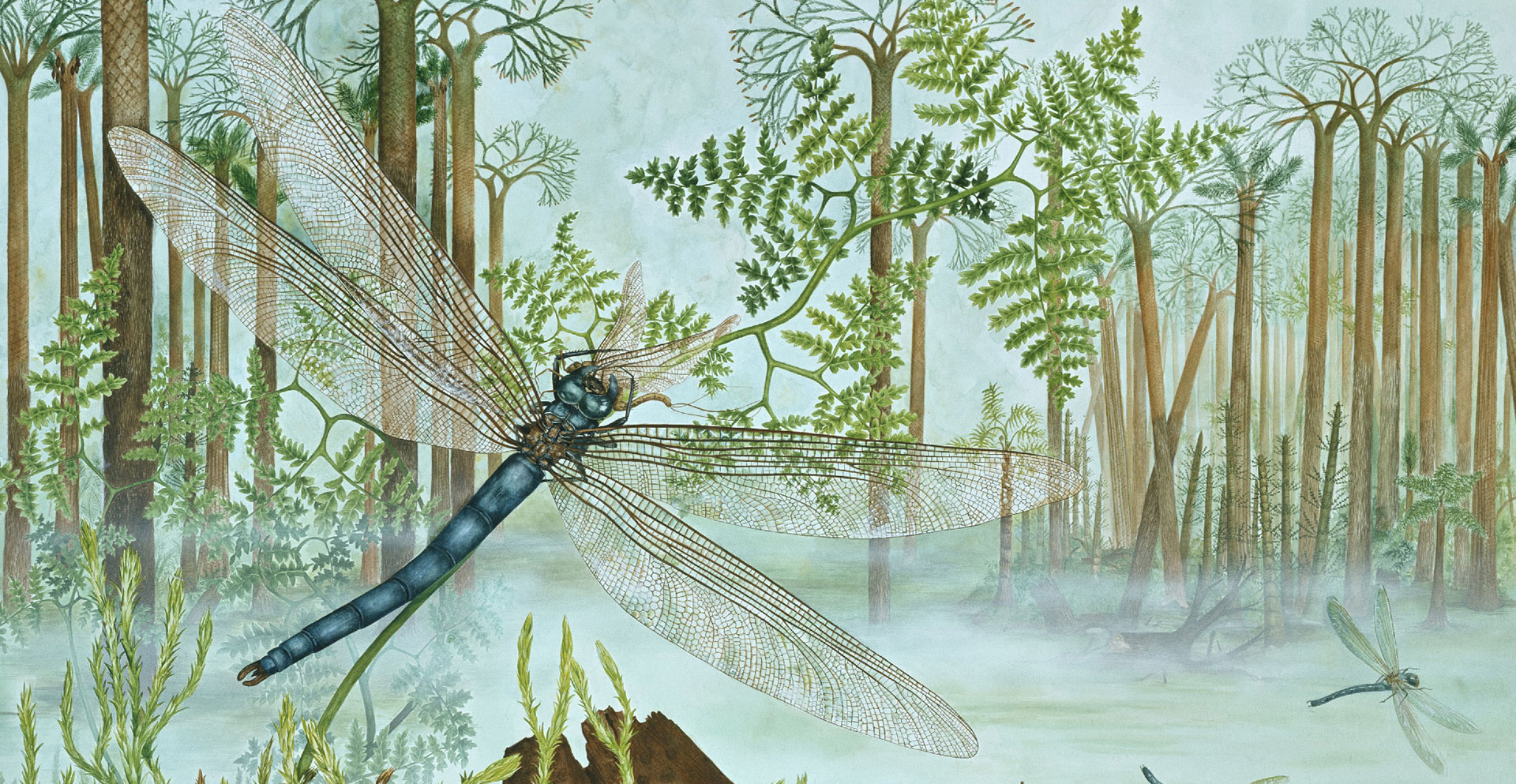
Don't miss a thing
Receive email updates about our news, science, exhibitions, events, products, services and fundraising activities. We may occasionally include third-party content from our corporate partners and other museums. We will not share your personal details with these third parties. You must be over the age of 13. Privacy notice.
Follow us on social media